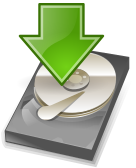OpenGL Programming

Welcome to the OpenGL Programming book. OpenGL is an API used for drawing 3D graphics. OpenGL is not a programming language; an OpenGL application is typically written in C or C++. What OpenGL does allow you to do is draw attractive, realistic 3D graphics with minimal effort. The API is typically used to interact with a GPU, to achieve hardware-accelerated rendering.
You are free, and encouraged, to share and contribute to this wikibook: it is written in the spirit of free documentation, that belongs to humanity. Feel free to make copies, teach it in school or professional classes, improve the text, write comments or even new sections.
We're looking for contributors. If you know about OpenGL, feel free to leave comments, expand TODO sections and write new ones!
Introduction
[edit | edit source]Setting Up OpenGL
[edit | edit source]- Installation on GNU/Linux
- Installation on Macintosh
- Installation on Windows with Code::Blocks
- Installation for Android NDK development
- with a GLUT-like wrapper to follow the exercises
- Installation for iPhone development
- Installing GLUT
Modern OpenGL
[edit | edit source]"Modern" OpenGL is about OpenGL 2.1+, OpenGL ES 2.0+ and WebGL, with a programmable pipeline and shaders.
The basics arc
[edit | edit source]| 01 |  |
Tutorial 01: newcomer's introduction, first dive into shaders | 02 |  |
Tutorial 02: adding more robustness to our code, transparency |
| 03 |  |
Tutorial 03: passing information to shaders: attributes, varying and uniforms | 04 |  |
Tutorial 04: transformation matrices: positioning and rotating |
| 05 | 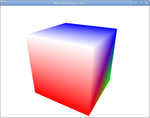 |
Tutorial 05: adding the 3rd dimension: a cube, plus a camera | 06 |  |
Tutorial 06: textures: displaying a wooden cube |
| 07 |  |
OBJ format: loading Suzanne the monkey from Blender | 08 |  |
Navigation: navigate in 3D space and manipulate objects in our model viewer |
Tutorial_drafts: ideas and notes for upcoming tutorials
The lighting arc
[edit | edit source]This series of tutorials is a C++ port of the GLSL wikibook Basic Lighting tutorials.
| 01 |  |
Diffuse Reflection: about per-vertex diffuse lighting and multiple light sources of different kinds | 02 |  |
Specular Highlights: about per-vertex lighting |
| 03 |  |
Two-Sided Surfaces (about two-sided per-vertex lighting) | 04 |  |
Smooth Specular Highlights (about per-pixel lighting) |
| 05 |  |
Two-Sided Smooth Surfaces (about two-sided per-pixel lighting) | 06 |  |
Multiple Lights (about for-loops for handling multiple light sources) |
This series of tutorials is a C++ port of the GLSL wikibook Basic Texturing tutorials.
| 01 |  |
Textured Spheres: about texturing a sphere | 02 |  |
Lighting Textured Surfaces: about textures for diffuse lighting |
| 03 | 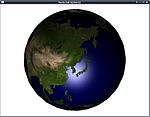 |
Glossy Textures: about gloss mapping | 04 |  |
Transparent Textures: about using alpha textures for discarding fragments, alpha testing, and blending |
| 05 |  |
Layers of Textures: about multitexturing |
This series of tutorials is a C++ port of the GLSL wikibook tutorials about Textures in 3D.
| 01 |  |
Lighting of Bumpy Surfaces: about normal mapping | 02 |  |
Projection of Bumpy Surfaces: about parallax mapping |
| 03 |  |
Cookies: about projective texture mapping for shaping light | 04 |  |
Light Attenuation: about texture mapping for light attenuation and lookup tables in general |
| 05 |  |
Projectors: about projective texture mapping for projectors |
There are more tutorials to port at the GLSL wikibook!
The scientific arc
[edit | edit source]| 01 |  |
Graph 01: plotting a simple function, using vertex buffer objects and point sprites | 02 |  |
Graph 02: plotting a graph from data in a texture |
| 03 |  |
Graph 03: plotting borders and axes, clipping | 04 | 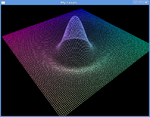 |
Graph 04: plotting a three-dimensional graph |
| 05 |  |
Graph 05: plotting a surface with hidden line removal |
And more to come.
Selected topics
[edit | edit source]| 01 |  |
Virtual Trackball: intuitive object rotation with the mouse | 02 |  |
Bounding box: draw a cube around your object for editing or debugging purposes |
| 03 |  |
2D-on-3D: hardware-accelerated 2D programming | 04 | Video Capture: capture your animation using apitrace (C++) or JavaScript (WebGL) | |
| 05 | 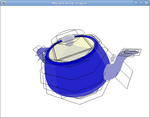 |
Tea time: generating an HD teapot from Bézier surfaces | 06 | 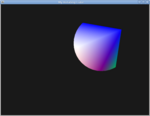 |
Stencil buffer: masking and combining |
| 07 |  |
Quadrics: creating simple shapes with a bit of maths | 08 |  |
Basic text: rendering text using the FreeType library |
| 09 |  |
Optimized text rendering: using a texture atlas containing all glyphs | 10 |  |
Object selection: unprojecting coordinates and object identification using the stencil buffer |
| 11 |  |
Anti-Aliasing: smoothing lines | 12 |  |
Particle systems: differents kinds of particle systems |
The post-processing arc
[edit | edit source]| 01 |  |
Concepts: how to perform full-screen post-processing, first example with a simple animated wave | 02 |  |
???: next effect to be decided! |
Mini-portal
[edit | edit source]This series shows how to implement a teleportation system similar to Valve's Portal, step-by-step, using OpenGL.
| 01 |  |
Mini-Portal: a first working see-through portal | 02 |  |
Mini-Portal Smooth: smooth transition, understanding the camera |
| 03 | 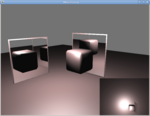 |
Mini-Portal Recursive: recursive portals - display portals within portals | 04 |  |
Mini-Portal Optimization: optimization with scissors |
Glescraft
[edit | edit source]This series shows how to render a voxel based world, similar to Minecraft.
| 01 |  |
Glescraft 1: basic voxel rendering | 02 |  |
Glescraft 2: removing unnecessary voxel faces |
| 03 |  |
Glescraft 3: texturing, lighting, fog, transparency | 04 |  |
Glescraft 4: first person camera controls |
| 05 |  |
Glescraft 5: drawing only what is on screen | 06 |  |
Glescraft 6: adding and removing voxels |
| 07 |  |
Glescraft 7: using geometry shaders |
Using the accumulation buffer
[edit | edit source]| 01 |  |
Tutorial 01: motion blur | 02 |  |
Tutorial 02: full-screen supersampling anti-aliasing |
| 03 |  |
Tutorial 03: depth of field | 04 |  |
Tutorial 04: order-independent transparency |
Note: not all videocards support accumulation buffer
Cutting-edge OpenGL
[edit | edit source]If you do not target old mobile devices or the web, you can upgrade to OpenGL (ES) 3.x / 4.x. It notably introduces new kinds of shaders: Geometry, Tessellation Control and Tessellation Evaluation, and Compute.
| 01 |  |
Tutorial 01: modify and create vertices on the fly with geometry shaders | 02 |  |
Tutorial 02: dynamic mesh quality with tesselation |
and lots of other features.
Code quality
[edit | edit source]| 01 |  |
Debugging: tips to help debug your OpenGL code | 02 |  |
Performance: measuring and improving your application performance. |
Appendices
[edit | edit source]- OpenGL ES 2.0 Overview: OpenGL ES 2.0 (OpenGL for Embedded Systems 2.0) concepts and its differences to normal OpenGL
- Migrating from 1.x to 2.x: how to upgrade your code to use modern OpenGL
- Glossary: what do all those new weird words mean?
- APIs, Libraries and acronyms: how all acronyms relate to each others
- OpenGL Shading Language: elements of GLSL programming
- Shaders reference: input and output variables list
- Team: contributors to this wikibook
- Download code: wikibooks-opengl code repository
Legacy OpenGL 1.x
[edit | edit source]"Legacy" OpenGL is about OpenGL 1.x and OpenGL ES 1.x, with a fixed pipeline and no shaders.
Starting Tutorial
[edit | edit source]- Setting Up A Programming Environment On Windows

- Setting Up OpenGL In The Programming Environment

- Drawing Primitives

- Immediate Mode
- Display Lists
- Vertex Arrays
- Basic Transformations

- Translation
- Rotation
- Scaling
- Custom Transformations
Basics
[edit | edit source]- Structure of a Typical OpenGL Application

- Drawing Rectangles

- Drawing Lines and Points
- Drawing Simple 2D Shapes

- OpenGL Naming Conventions

- Using Color

- Viewing Transformations

- Drawing Simple 3D Objects
- Perspective versus Orthographic Projections
Intermediate
[edit | edit source]- Smoothing Polygons with Normals
- Adding Lights
- Using Materials
- Using Textures
- Using Mipmaps
- Drawing Complex Polygons Using Tessellation
Advanced
[edit | edit source]- Optimizing OpenGL Code
- Drawing Shadows
- Drawing Using Quadrics
- Drawing Using NURBS and Curves
- Ambient Occlusion
Appendices
[edit | edit source]- Coordinate Transformations
- Understanding Transformation Matrices
- OpenGL Library Reference. functions and type reference for gl.h glu.h and glut.h
- Why OpenGL Exists and What It's Good For
- Migrating from 1.x to 2.x: how to upgrade your code to use modern OpenGL
External links
[edit | edit source]Wikibooks
[edit | edit source]Related WikiBooks:
- GLSL Programming : wikibook on the use of the OpenGL Shading Language (GLSL) in Unity 3 and Blender 2.5, with much information on lighting and texturing
- Blender 3D: Noob to Pro: comprehensive book on using the Blender 3D modeling environment
- an open source, cross-platform IDE's for exploring pixel based graphics on the GPU using GLSL :
Ports
[edit | edit source]The following websites provide conversion of the tutorials to other programming languages or platforms:
- Official code repository contains the main SDL2 version, but also GLUT and WebGL ports
- port to Lightweight Java Game Library (LWJGL) (blog)
- not really a port, but commented, progressive version of the tutorials code as the author follows them
Freely-licensed documentation and samples
[edit | edit source]- OpenGL ES 2.0 Reference Pages: official reference man pages, SGI Free Software B License
- Learning Modern 3D Graphics Programming: another modern OpenGL tutorial, requiring v3.3 or later, MIT license (source repository)
- Learn OpenGL ES: Detailed, step-by-step OpenGL ES tutorials in Java for Android, and a bit of WebGL as well, CC BY-SA 3.0 license (source repository − Apache License 2)
- OpenGL Samples Pack: written in C++ based on the "core profile" specifications, aimed at easing upgrades to new OpenGL versions and features, MIT license (source repository)
- Introduction and examples for OpenGL 3.3
Template:Fix/category[dead link]: GFDL license
- A modern OpenGL FAQ: GFDL license
- OpenGLContext Python Tutorials: basic tutorials using PyOpenGL (BSD-style licenses)
- Paul's projects: OpenGL 1.x, two tutorials on shadow mapping and bump mapping, with code under the MIT license
- WebGL:
- Gregg Tavares’ WebGL articles: detailed 2D and 3D basics with emphasing on matrix operations; lots of diagrams and interactive animations (source code − MIT license)
- WebGL at Mozilla Developer Network: WebGL overview, including embedding videos; CC BY-SA for articles, MIT and public domain for source code
- three.js: collection of demos using the three.js WebGL framework; source code is MIT but models/data may be non-free
Non-freely-licensed documentation
[edit | edit source]- NeHe's OpenGL tutorial: OpenGL 1.x
- Collection of OpenGL fundamentals tutorials using C++ and Windows API: OpenGL 1.x
- ZeusCMD OpenGL Tutorials: OpenGL 1.x
- OpenGL Programming Examples: OpenGL 1.x,
Websites
[edit | edit source]- OpenGL Lighting Model Tutorial with Examples
- Official OpenGL Website
- Mesa, an open-sourced 3D graphics library almost identical to OpenGL
Further reading
[edit | edit source]- OpenGL Architecture Review Board, et al: OpenGL Programming Guide: The Official Guide to Learning OpenGL, Version 2, Fifth Edition, Addison-Wesley, ISBN 0-321-33573-2
- OpenGL Architecture Review Board, et al: OpenGL Reference Manual: The Official Reference Document to OpenGL, Version 1.4, Addison-Wesley, ISBN 0-321-17383-X
- Wright, Richard S. Jr and Lipchak, Benjamin: OpenGL SuperBible, Third Edition, Sams Publishing, ISBN 0-672-32601-9
